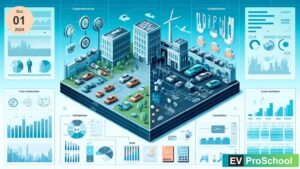In the complex journey of revenue recognition under IFRS 15, Step 4 marks a crucial turning point: allocating the transaction price to each performance obligation identified in a contract. This step ensures that the transaction price is fairly distributed among the goods or services promised to the customer, based on their stand-alone selling prices. For engineers and professionals in the electric vehicle (EV) sector, understanding this process is vital for accurate financial reporting and strategic pricing decisions.
The Essence of Allocation
At its core, allocation in Step 4 revolves around the concept of the stand-alone selling price (SSP) — the price at which an entity would sell a promised good or service separately to a customer. But what happens when a bundle of goods or services is sold at a discount? Herein lies the art and science of allocation.
Allocation of a Discount
Discounts are common in the EV industry, especially when customers purchase bundles, such as an EV along with a charging station and a maintenance package. The allocation of these discounts across performance obligations must be proportional to their SSPs, ensuring each segment of the bundle is accurately valued.
However, if there’s clear evidence that the discount pertains solely to specific parts of the bundle, then the discount is allocated only to those components. This nuanced approach allows for a more precise reflection of revenue.
An Illustrative Example: ElectroCar Bundle Sale
Scenario Overview:
ElectroCar, an emerging name in the EV market, offers a special bundle: an EV, a home charging station, and a 2-year service and maintenance package. The bundle is priced at ₹800,000, representing a discount over purchasing each component separately.
- Stand-alone Selling Prices:
- EV: ₹750,000
- Charging Station: ₹50,000
- Service Package: ₹30,000
- Total if purchased separately: ₹830,000
The Allocation Process:
Given the ₹30,000 discount on the bundle, ElectroCar needs to allocate this discount across the three performance obligations.
- Calculate SSP Proportions:
- EV: ₹750,000 / ₹830,000 = 90.36%
- Charging Station: ₹50,000 / ₹830,000 = 6.02%
- Service Package: ₹30,000 / ₹830,000 = 3.61%
- Allocate the Discount:
- Discount allocation based on SSP proportions:
- EV: 90.36% of ₹30,000 = ₹27,108
- Charging Station: 6.02% of ₹30,000 = ₹1,806
- Service Package: 3.61% of ₹30,000 = ₹1,083
- Determine Transaction Price Allocation:
- EV: ₹750,000 – ₹27,108 = ₹722,892
- Charging Station: ₹50,000 – ₹1,806 = ₹48,194
- Service Package: ₹30,000 – ₹1,083 = ₹28,917
Conclusion:
The transaction price allocation allows ElectroCar to recognize revenue for each performance obligation in a way that accurately reflects the value of the bundle deal offered to the customer. This process not only adheres to the principles of IFRS 15 but also provides transparency and fairness in financial reporting, crucial for building trust with customers and investors.
In the fast-paced EV sector, where innovation and competitive pricing are key, mastering the allocation of the transaction price is essential for businesses aiming to navigate the financial landscape effectively. By dissecting this process through examples like ElectroCar’s, engineers and non-financial professionals can gain insights into the strategic financial mechanisms underpinning successful product offerings.
Step 5: Recognizing Revenue When Performance Obligations Are Satisfied
The fifth and final step in the revenue recognition process under IFRS 15 is a critical juncture where an entity determines when and how much revenue to recognize. This step hinges on the concept of transferring control of goods or services to the customer, signifying the satisfaction of a performance obligation. Understanding this step is paramount for entities in dynamic industries, such as the electric vehicle (EV) sector, where the timing of revenue recognition can significantly impact financial statements.
Transferring Control of an Asset
Control of an asset is considered transferred when the customer has the ability to direct the use of, and obtain substantially all of the remaining benefits from, the asset. This can occur at a specific point in time or over a period.
Performance Obligations Satisfied at a Point in Time
Revenue is recognized at a point in time when control of the asset is transferred to the customer, which can be determined by several indicators, including:
- The entity has a present right to payment.
- The customer has legal title to the asset.
- The entity has transferred physical possession of the asset.
- The customer has accepted the asset.
Example: ElectroDrive sells an EV to a customer. The performance obligation is satisfied at the point in time when the customer takes delivery of the vehicle and gains control over it. At this moment, ElectroDrive can recognize the revenue associated with this sale.
Performance Obligations Satisfied Over Time
Some obligations are satisfied over time if one of the following criteria is met:
- The customer simultaneously receives and consumes the benefits as the entity performs.
- The entity’s performance creates or enhances an asset that the customer controls as the asset is created or enhanced.
- The entity’s performance does not create an asset with an alternative use to the entity, and the entity has an enforceable right to payment for performance completed to date.
Example: VoltTech enters a contract to install a series of charging stations for a city’s public transportation system. This performance obligation is satisfied over time because the city controls the asset (charging infrastructure) as it’s created and enhanced.
Measuring Progress
To measure progress toward satisfying a performance obligation satisfied over time, acceptable methods include:
- Output Methods: Measure the value to the customer of the goods or services transferred to date.
- Input Methods: Measure the entity’s efforts or inputs to the satisfaction of a performance obligation relative to the total expected inputs.
Example: If VoltTech measures progress based on the number of charging stations installed (an output method), revenue can be recognized based on the proportion of the total number of stations installed at any reporting date.
Conclusion
The ability to accurately recognize revenue at the right time is a cornerstone of fair and transparent financial reporting, especially in industries like the EV market, where both goods and services play vital roles in revenue generation. Whether obligations are satisfied at a specific point in time or over a duration, entities must carefully assess and apply IFRS 15’s principles to ensure they reflect the true nature of their transactions. This nuanced approach aids in presenting a clear picture of an entity’s financial performance, fostering trust among stakeholders and supporting strategic decision-making.
Here’s a blog post on revenue recognition and contract measurement based on the IFRS 15 standard. The examples are tailored to align with the Electric Vehicle (EV) industry and provide an easy-to-understand perspective for engineers and non-financial readers.
Title: Engineering Profit: The Essentials of Contract and Revenue Recognition in the EV Industry
Abstract (33 Words):
A comprehensive guide to the principles of revenue recognition and contract measurement within the electric vehicle sector, deciphering complex accounting standards into engineer-friendly concepts.
Blogpost Feature Image Description:
A visually engaging depiction of the EV industry with financial documents symbolizing contract measurement overlaid with electric vehicles and charging station icons to represent revenue recognition stages.
Alt text:
“Contract and Revenue Recognition in the Electric Vehicle Industry – An integration of accounting precision with engineering innovation.”
Caption:
“Where Engineering Meets Accounting: The Intersection of EV Technology and Financial Standards.”
Description:
This feature image captures the essence of applying the IFRS 15 standard within the dynamic landscape of the electric vehicle industry, focusing on the meticulous process of contract and revenue recognition.
Understanding Contract Assets and Revenue Recognition in the EV Industry
In the realm of electric vehicles (EVs), where technology meets commerce, the intricacies of financial accounting standards are as crucial as the engineering marvels on the road. IFRS 15 brings a structured approach to recognizing revenue and measuring contracts, ensuring transparency and consistency across the industry.
The Four-Step Measurement Approach
Step 1: Overall Profit or Loss Calculation
In this step, EV companies calculate their overall profitability. This is a straightforward determination of financial health: revenues minus expenses.
Step 2: Progress Towards Completion
This is where the real engineering perspective shines. EV companies often engage in long-term projects. Progress towards completion can be measured by input methods (costs incurred) or output methods (work certified), much like tracking the development progress of a new EV model from concept to production.
Step 3: Statement of Profit or Loss Inclusion
After ascertaining the progress, the next step is incorporating these figures into the Statement of Profit or Loss (SOPL). This includes revenue (factoring in progress) and the corresponding cost of sales, similar to how an EV company would account for the sales of vehicles during a quarter.
Step 4: Statement of Financial Position Inclusion
Finally, the contract assets or liabilities are calculated and reported on the Statement of Financial Position (SOFP). For an EV company, this could resemble the prepayments received for vehicles yet to be delivered or the costs incurred for the development of a new battery technology not yet completed.
The Application in the EV Sector
To better understand these principles, let’s look at a hypothetical EV company, ElectraMotors:
- Contract Asset Calculation: ElectraMotors is developing a new battery technology. The costs incurred to date, the profit recognized, and the billing progress all contribute to the contract asset or liability.
- Accounts Receivable Management: With EVs sold and down payments received for future deliveries, ElectraMotors meticulously tracks progress billings against payments received to maintain an accurate accounts receivable balance.
Through these steps, ElectraMotors ensures a transparent and accurate financial portrayal of its business dealings, reinforcing investor confidence and paving the way for sustainable growth in the competitive EV market.
Deciphering the financial aspects of contract measurement and revenue recognition, especially in the innovative EV sector, provides engineers and industry professionals with a clearer understanding of their company’s economic performance, ensuring that they are not only creating the vehicles of the future but also driving their businesses forward with solid financial understanding.
[Insert Image – “ElectraMotors’ Journey of Contract Measurement and Revenue Recognition”]
Conclusion:
Wrapping up, the journey from battery technology development to the sleek EVs on our roads is paved with not only technological prowess but also financial acumen. The implementation of IFRS 15 in the EV industry underscores the harmony between engineering feats and financial literacy, a duality that propels the industry towards a future where innovation accelerates and integrity prevails.
[End of Blog Post]
I hope this helps to break down the content into an informative and accessible format for your blog readers! If you need further details or another topic covered, feel free to ask.


